In the ever-changing world of online marketing, where things are really competitive, there’s a group of people who run businesses in areas like coaching, consulting, speaking, or being experts.
They’ve got a lot of money to spend on ads, like over $10,000 every month. Their businesses are doing really well, making them a lot of money, maybe even millions. They’ve worked really hard to set up their online sales systems to make lots of profit.
But, there’s a problem lurking beneath all their success – Facebook ads.
More specifically testing Facebook ads and finding winning variations that will help them sustain or scale their growth.
In order to keep the lights on, they need to test variation after variation and ad-on ad to keep their Facebook accounts pumping in new business consistently.
Coming up with new ideas can really get dry and boring after you’ve been advertising for so long.
Especially if you’re trying to run a business alongside it.
In today’s article, we’re going to discuss our top Facebook ad testing strategies you can take and implement today.
Why You Need to Test Your Facebook Ads
Without testing new ads, you’re going to be in a world of hurt especially if you have performing ads now and you think they’re just going to last forever.
The truth is markets change, people’s tastes change, and in order to stay on top of it, you need to have a proactive approach.
This is where the 80/20 budget rule comes into play because in order to get the best results in the present, we recommend putting 80% of your budget towards what’s working the best and to make sure you’re planning for when that stuff no longer works, we also recommend putting 20% of your budget to testing new things.
Constantly pushing the needle with better optimization strategies, improved creatives, and new variations of copy will allow you to sustain your success long-term.
The Three Levels of Facebook Ad Testing
Campaign
Five Different Types of Campaigns and When and How to Use Them
1. Creative Tester
The creative tester campaign is designed to create a system for continuously testing new and different variations of ad creatives.
The goal is to take a proactive approach to one of the biggest challenges on Facebook which is experiencing creative fatigue.
One day you’re riding high, making sales, and experiencing great profit in your business, and then the next your audience is tired of seeing the same ad over and over again.
The creative tester is the solution to this and will help you sustain your desired level of success.
In fact, once you have found your desired level of success through Facebook ads, this is the time you want to be pushing out new creatives to find new winners.
You ALWAYS want to be taking a proactive approach to testing new ad creatives so this is a campaign you need to be running 24 hours a day, 7 days a week, and 365 days a year.
We use creative testing all the time in order to find new winning creatives before the problem of fatigue even hits the table of cards.
In order to do a proper creative test, you need to have a control variable which is a winning audience selection as well.
We’ll talk about the specifics of what to test in these campaigns once we get down to the ad level.
2. Audience Tester
The audience tester campaign is a very similar concept to the creative tester.
This addresses the other huge challenge on Facebook which is experiencing audience fatigue.
If you have a slim, winning audience portfolio, then you won’t have a lot of options.
The game starts to get really fun once you have a ton of winning options to play around with.
So the audience tester is all about taking a proactive approach to audience fatigue and you want to be running this campaign 24 hours a day, 7 days a week, and 365 days a year.
Again, we know you’re dying to hear the specific examples of what to test in this campaign.
Just stick with us while we go over the five types of campaigns and we’ll get into the nitty-gritty details of what to test in all of these campaigns with examples of each.
3. Scaler
The scaler campaign is exactly as it sounds.
This is the CBO campaign you’ll plug all of your winning combinations into.
Once you know what Facebook wants from you, it becomes simple to spend higher budgets.
Imagine a campaign stuffed with a bouquet of winning images, videos, and all your favorite audiences consistently producing you a 3.0 – 4.0 ROAS like clockwork.
The scaler campaign makes my mouth water just thinking about it.
The proper timing to use this campaign is when you have those winning combinations and you’re ready to start increasing your budget.
4. Re-Engagement Campaign
This campaign is dedicated to your warm audience pools.
You know the people who have seen your ad, viewed your page and watched one of your videos 75% of the way through.
Yeah, those guys who have shown a little bit of interest and have nibbled at the bait you have set out.
Odds are there are some future buyers in these audiences and you want to hit them with your hardest-hitting creatives.
Obviously to have a warm audience pool you’re going to need to build them.
Ever heard the saying “Build it and they will come”?
Well in this case they have to come to your front door first for you to be able to build it.
Plus if your warm audiences are super small, then when you try to publish your campaign it won’t spend at all.
So if you’ve got a good size warm audience, then you’ll definitely want to start building this campaign.
And well if you don’t, then it’s only a matter of time before you’ll want to as well.
5. We Miss You Campaign
You know there are those acquaintances/friends or whatever you want to call them that you can go weeks without seeing them…
… and then there’s those friends who just can’t seem to go a day without.
Well, your hot audiences should definitely be a part of the group who don’t go a day without seeing your ads on their screens.
Are your retargeting campaigns a desperate attempt to say “We miss you. Please come back to our funnel…”?
Maybe…
But are they also super profitable and multi-faceted in their nature?
You bet!
The We Miss You campaigns are all about picking up those people who have taken valuable actions either by visiting your website, watching your webinar, or even booking a call without showing up.
In order to truly take advantage of these ‘Pack-a-Punch’ campaigns, you need to have some skin in the game and at least 1,000 people in your Website Viewer, Webinar Watcher, and Booked Callers audiences.
Without it, you won’t see a single penny credited over to Meta on your balance sheet.
Pros and Cons of Campaign Budget Optimization (CBO)
I know…
More information and no examples yet?
Blah blah blah when are you going to get to the good stuff?
All of this is to set the preface for what’s to come!
You gotta get the basics and fundamentals down before you start reaping the rewards of Facebook ads.
Patience young grasshopper; we’ll make a Facebook Ad Testing master of you yet.
Campaign Budget Optimization (CBO)
One notable option we have at the campaign level is the automated campaign budget feature.
We solely use this feature to scale campaigns and to plug our winners from our test into these types of campaigns.
If you want to learn more about how we use the CBO campaigns in order to scale ad accounts, then click here.
The Top Two Objectives to Use For a High Ticket Offer and When We Test Them
Leads Objective
The lead objective is designed to help you pick up more opt-ins, appointments, registrations, and even more actions taken on your site.
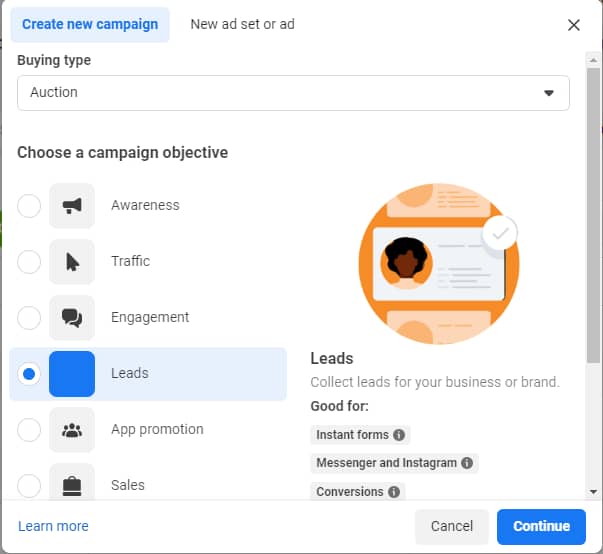
This is a great objective to start out with for your campaigns if you don’t have much data in your account.
We recommend targeting those early events in your funnel at the forefront of your ad strategy.
The lead objective will continue to improve over time as you continue to pour more and more data into your account.
Sales Objective
We start testing the sales objective once we have an adequate amount of sales data in the account.
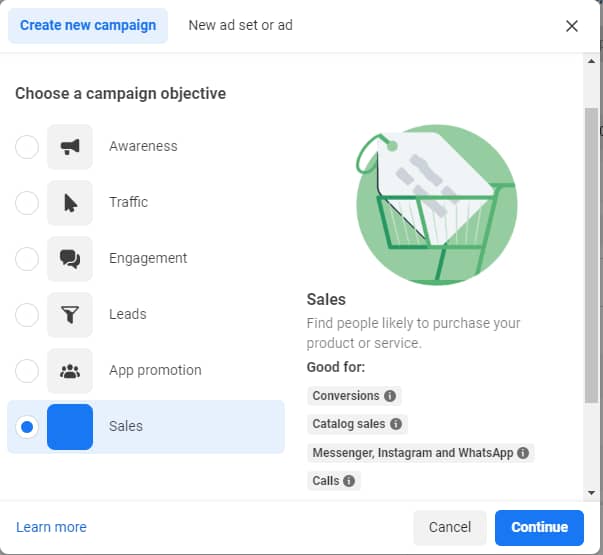
This objective style is designed to take all of the purchasers’ data into account and optimize your campaigns to find more people like them.
In order to make this work well, you need to have a considerable amount of data so that Facebook can profile this person much better.
We recommend you test this feature out once you have 100 sales conversions in the account.
Even at 100 conversions, there is a slim chance that this objective doesn’t work very well for you and we often find it’s because of the lack of data within the account.
Ad Sets
Next up we have the ad set level and there is a TON of different variables you can test here.
In this section, we’ll let you know the best testing tips we have at the ad set level for everything from pixel optimization to where to place your ads.
Pixel Optimization
Leads Objective Campaigns
When you optimize your campaigns for the lead objective, you’ll want to select the conversion event most applicable to your objective.
This can include leads, registrations, initiate checkout, add to cart, view content, and more.
You want to go as far down the funnel as possible but you also want to make sure the event you select has at least 100 conversions or more.
Don’t worry if you don’t have 100 conversions at the event you want to optimize for yet.
Just pay close attention to that event and as soon as you get 100 conversions, throw it into a campaign and test it out.
Set up an ad set budget optimization campaign (we’ll touch on this more in just a bit…) and plug in your best-performing audiences and creatives to split test which event is going to work best for you.
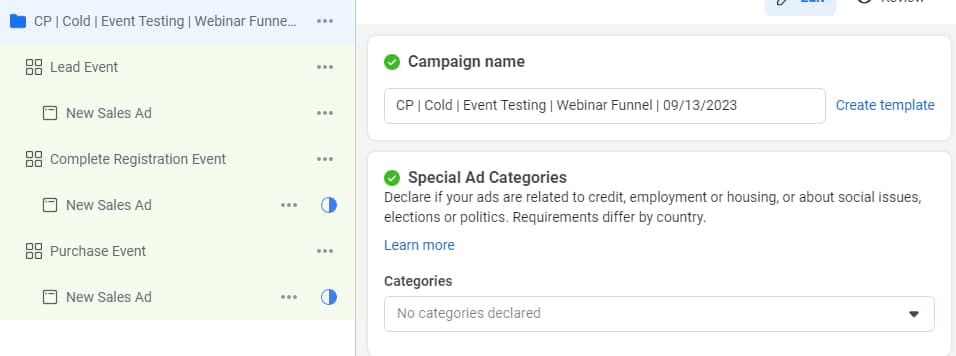
Sales Objective
For setting up your sales objective campaigns, you’ll want to take a slightly different approach.
Instead of selecting your lead-based events, you’ll set up the different purchase events you have firing.
Some people only have one but since we run third-party tracking with offline events, we have a couple of different events we can test.

Our third-party tracking system setup with Hyros has much more accurate sales data and can be an amazing event to optimize for.
In order to get the best sales data possible, we highly recommend setting this up for your high ticket offer.
Using Adset Budget Optimization (ABO) for Testing New Things
Why It’s a Best Practice
In order to get the most control when you are testing, it is best to use ad set budget optimization.
Whether you’re testing new event strategies, ad creatives, or audiences, you’ll want to set your testing budget at the ad set level so you can control how much money goes into each variable you’re testing per day.
If you set your budget at the campaign level, then Facebook will disperse the budget across the variations they think are doing the best for you.
Often what we find is that Facebook doesn’t make the best budget allocation decisions when it comes to testing because they don’t have the sales data we do in Hyros.
Budget Control
Let’s say you have winning ads and audiences already and you just want to add more to your portfolio.
You’re spending $1,000 per day which comes out to about $30,000 per month.
What we would do is put $100 – $200 per day into testing new variations so we can find new winners for the account.
For example, let’s say we go with $200 per day for your testing budget because we aggressively want to find new winners.
We have ten new creatives we want to test so we pair them up with a few of your best-performing audiences.
Now we have ten different ad sets at $20 per day.
This is a relatively low spend per day per ad set but it will allow us to find new winners in the next couple of weeks to a month.
The way we figure this out is by using the target KPI’s.
If the targets are:
$20 Cost Per Lead
It will only take us a few days to identify ads that are performing for our target cost per lead.
Let’s say 3 days go by and we spend $60 and get 4 leads.
This ad is winning for our target CPL because $60 / 4 = $15.
$200 Cost Per Booked Call
The cost per booked call will take 10-15 days to find a potential winner.
After 10 days, we will have spent $200 and after 15 days will be $300.
We typically shut off a test once it gets 2x out of KPI so we’ll look at shutting off our losers at 20 days.
$1,500 Cost Per Acquisition
An acquisition ‘can’ take the longest to identify winners but often we find these ads spending at low budgets get really good CPA’s.
This is another benefit of running these low-budget campaigns.
The thing is it will take 75 days to spend $1,500 at $20 per day.
So what we do with our testing campaigns is find the winning ads performing at our Cost Per Lead, Cost Per Booked Call, or other events earlier in the funnel than the Acquisition.
We’ll take these ads and put them into higher spending campaigns but we leave the ones in the testing campaign to perform in the background.
This gives a good chance to get cheap CPA’s with the ads still in the testing campaign and an opportunity to see how the ad spends at a higher budget.
Our Best Practices for Testing New Audiences
Single Interests
These are without a doubt some of the most profitable audiences we use.
Take these few ad sets for example.

Remember what I said about low-budget campaigns getting a really nice CPA?
The Mark Cuban interest ad set here picked up 5 sales for just $492.01.
While the AI ad set is doing decent and sitting at a 1.85 ROAS.
However, the Robert Kiyosaki audience is not performing and hasn’t been profitable here.
So out of these three audiences:
One has been ultra-profitable.
One has been okay…
One has been unprofitable.
This is why we constantly test audiences because yes we may lose money on some but at the end of the day we’re going to find new audiences where we can strike gold like we did with the Mark Cuban interest.
Audience Stacks
Take this ad set for example where we stacked a bunch of military-related Lookalikes based upon leads, video viewers, opt-in page viewers, landing page visitors, and a scraped list of 2,300 veterans.
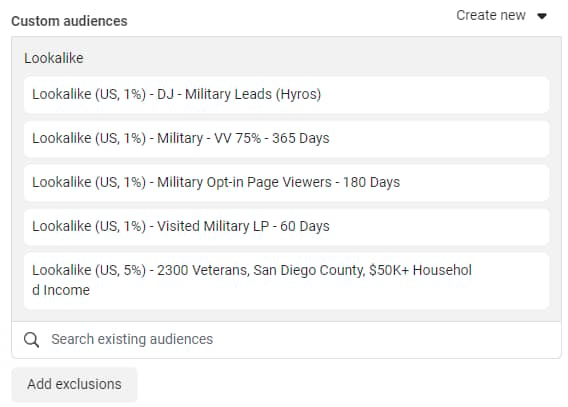
We put together all of the top-performing lookalikes in one ad set to expand the audience size and still target a super niche audience.
Here are some of the results so far.

You can also follow this same exact strategy with interests that are likely to convert well for your offer.
This ad set using Mark Zuckerberg, Mark Cuban, and Home Businesses has just started to take off for one of the self-liquidating offers we’re running.

How We Go About Testing New Demographics
Auditing Ideal Customer Profile (ICP)
When we look at testing new demographic ranges, we want to base it on ‘customer’ data instead of theory.
So we’ll collaborate together with our clients to come up with lists of their favorite clients to work with, their age ranges, gender, and where they are from.
This helps us identify unique insights about their ICP and who we might be targeting specifically with our demographics.
Age Ranges
Simply set up a demographics testing campaign like this.
In this one, we’re going to test our ICP age ranges against the broad age ranges we’ve been using.

Gender
There are a lot of businesses that only advertise to one primary gender but for those who advertise to both, it’s good to figure out what gender your offer leans towards.
Is it 75% male and 25% female?
If that’s the case you might find that your advertising is much more profitable by only targeting males in your demographic options.
Advantage+ Vs. Manual Placements
Since Facebook has rolled out their Advantage+ placement function, we have tested it across several campaigns and it has become the staple option we use across the board.
This is one area where we let Facebook take control and make decisions for us because it has proven to be the best option time after time.
Take this ad account for example where we have made $209,030.81 in profit using advantage+ placement options.

Ads
Six Things to Test to Improve Your Ad Performance
1. Single Image. Banner Images are the types of images you can crank out by the dozens which tend to perform pretty well.
If you and your team are too busy, then you can easily hire a designer on Upwork or Fiverr to get you a few dozen of these to test super cheap.
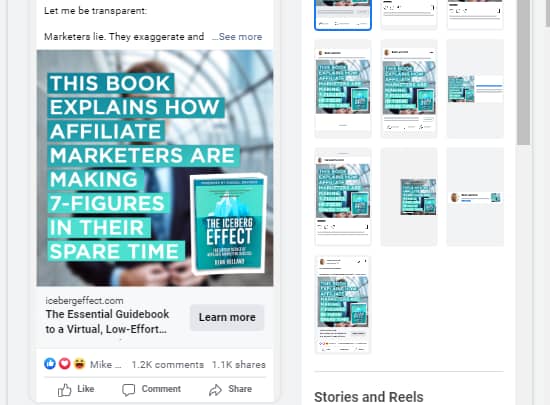
We identified this ad as a winner in 2022 and are still reaping the benefits of it today.
In this campaign, the ad has produced 582 sales, $36,440.30 in revenue, and a 2.25 ROAS.

2. Videos.
- The Talking Head. Our client put together a solid new video recently which is crushing it out of the gate with a stellar 5.4 ROAS.

This unique angle discusses the shift taking place in affiliate marketing in today’s world and positions his product as the simple yet effective solution his market is looking for.
Since affiliate marketing is close to that stage 5 of market sophistication, we knew his ads needed to be steered towards a ‘revival’.
- Banner with B-Roll, Captions, and Music
We know as business owners, it can be incredibly challenging to find time to sit down and talk in front of a camera.
This style of ad is a great option as it only requires images, a script, some music, and a video editor to bring it all together.
Plus it has been performing exceedingly well for our client pulling in 264 sales, $36,132.40 in revenue, and a 2.54 ROAS.

3. Body Copy
Revival Angle with Multiple CTA’s
In the body copy of the revival video discussed above, we talk about the evolution of affiliate marketing and introduce his book called “The Iceberg Effect”.
He shows how this industry shift has allowed him to create a 7-figure affiliate marketing business and how it can help others as well.
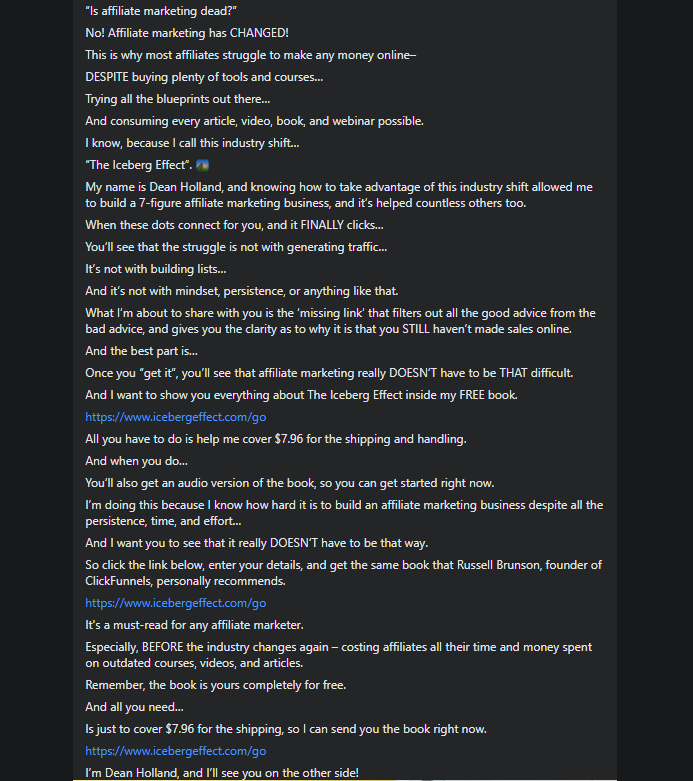
You’ll also notice that there are three different call to actions all going to the same landing page.
We incorporate these strategically because not everyone wants to read a long article when they are on Facebook.
In order to increase the amount of clicks you’re getting on your ad, incorporate this strategy and watch it work its magic for you.
Exposing Evil Angle
This body copy employs a theme of contrasting truth and lies, highlighting the advantages of affiliate marketing, and presenting his book as the solution to help his audience succeed in this field.
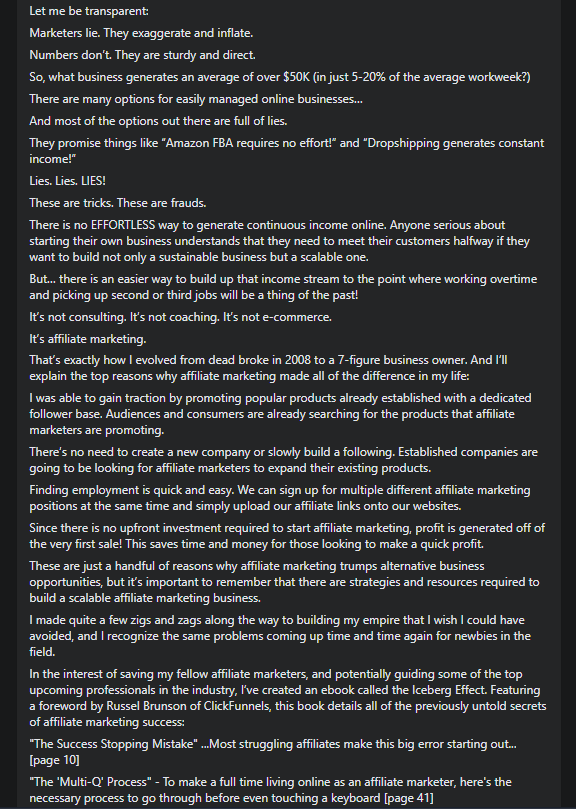
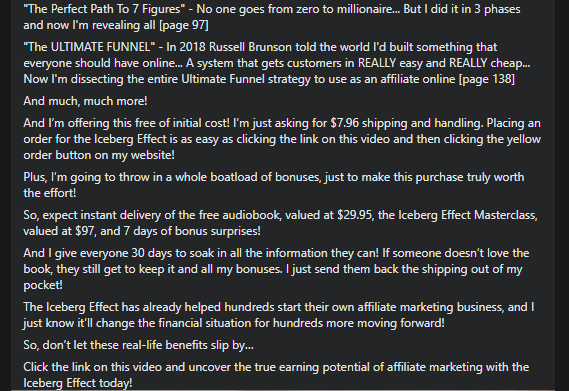
We used several persuasive techniques here to convince readers to action and make a purchase including:
Critique of other business models
Highlighting benefits
Personal success story
Teasing valuable content and information
Offering at a minimal cost
Bonuses
4. Headline
Consider this headline: Is Affiliate Marketing Dead?
After doing our market research, we were able to put together the common thread of what most people were thinking about in regard to affiliate marketing.
It has been around for quite some time and anyone in the business space has heard about it by now and has heard about every offer there is.
In order to work around the banner blindness and overall audience exhaustion from hearing the term, we decided to discuss the obvious.
I mean after doing one quick search on Quora the approach we should take to the ads became blatantly obvious.
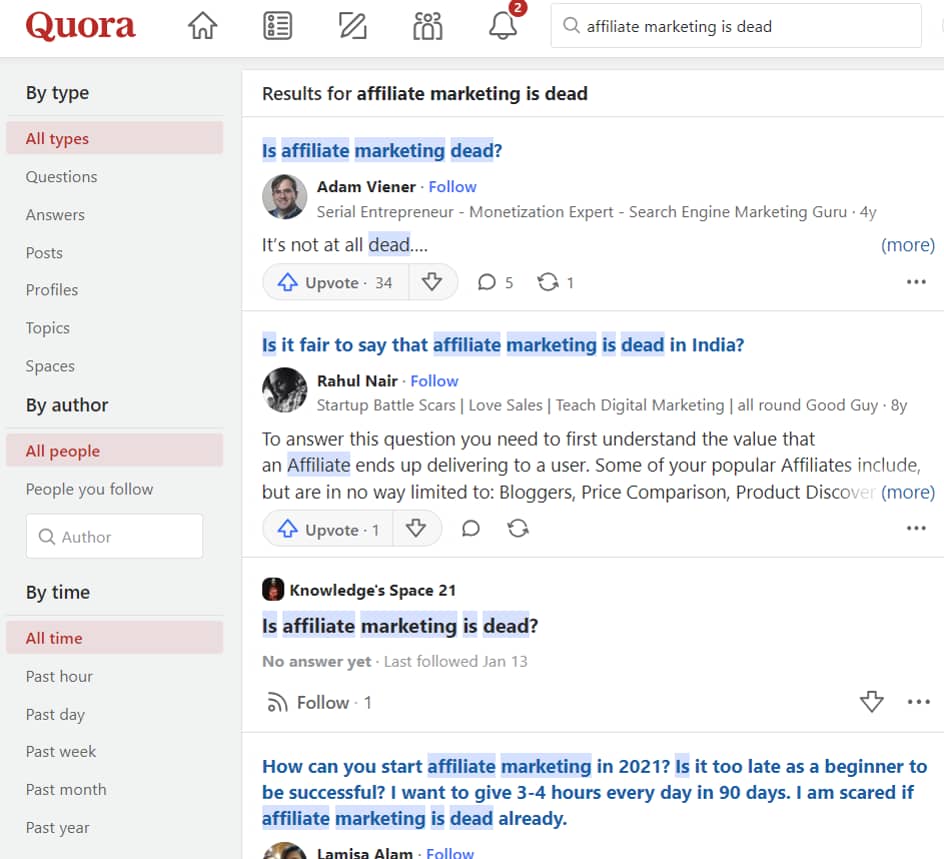
Doing the market research to find great angles to take for ads can be dry and boring but that’s exactly why most people struggle to succeed.
Go see what your market is talking about and they will give you all the ammunition you need for coming up with ads to test.
How to Budget Your Facebook Ad Testing
We talked about budget control earlier in the article but what budget allocation strategy do we use and why?
Well, we follow an 80/20 rule where we put 80% of our budget towards what is working the best in the present moment and set aside 20% of our budget to prepare for the future.
Let’s say you’re spending $100,000 per month on advertising.
Following the 80/20 rule, we’d spend about $80,000 per month on performing ads and then set aside about $20,000 per month to find more winning variations.
There are exceptions to this rule of course.
If you are in dire need of increasing your ROAS and need to see an increase in profitability for a period of time, then we would only put 5-10% of the budget towards testing.
The point is your budget allocation should be oriented towards sustainability.
We don’t just want to be thinking about now, we want to be thinking five to ten steps ahead.
The Only Facebook Ad Testing Framework You’ll Need
Step #1
Third-Party Tracking for More Reliable Results
In order to get the most out of your testing, we always set up Hyros.
Hyros is a third-party tracking service which you can learn more about by clicking here.
It allows us to tie back sales to the original creative it came from which is very crucial when you’re testing new ads.
The problem is that with high ticket offers, long sales cycles, app privacy laws, and cookies getting cleared, it’s very easy to lose attribution.
Hyros serves a centralized database for all of your advertising needs and is able to identify leads by their IP address, session ID, email, and phone number.
This helps make sure that you don’t lose any of that attribution along the customer journey.
Step #2
Data to Keep Your Eye On
We talked about a bunch of different things you can test today but one of the key takeaways is testing new audiences and optimizing for different events.
You’ll want to be sure to keep an eye on how many total events you have fired for your leads, booked calls, and sales so that you know when to test optimizing for a new event.
Additionally, we keep good data hygiene and are constantly updating our lookalike audiences to reflect the new and improved data we have across the board.
We do this on a monthly and quarterly basis to keep all of our ducks in a row and make sure we are targeting the best events and audiences as possible.
Step #3
Creating a Cyclical Media Buying Machine for Scaling Your Winners
While testing new things can be very fun and enjoyable, it’s important to remember why we’re doing it in the first place.
It’s to create a healthy and sustainable environment in our ad accounts which is profitable long term.
The whole point of testing is to make scaling much easier and a lot less troublesome.
See our article on the 3-phase system we use to scale up winners by clicking here.
Scale Your Facebook Ads With Client Accelerators Today
Scaling your Facebook ads successfully requires a strategic approach that involves meticulous testing and optimization. We’ve explored the most essential elements of testing your Facebook ads, from campaign objectives like leads to pixel optimization at the ad set level. By following these proven steps, you can accelerate your success with Facebook ad testing.
If you’d rather have our team of experts take care of all of these steps for you, book a call with us today. We’ll explore what your current major obstacles are and if we can help you overcome them. Let’s scale your Facebook ads without worrying about how to do it all yourself.


